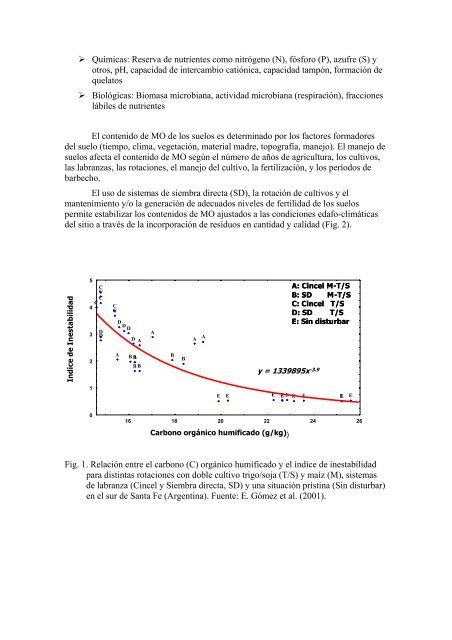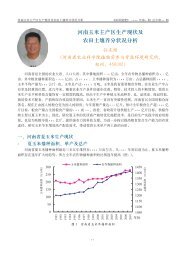SD rotación de cultivos y materia orgánica
SD rotación de cultivos y materia orgánica
SD rotación de cultivos y materia orgánica
You also want an ePaper? Increase the reach of your titles
YUMPU automatically turns print PDFs into web optimized ePapers that Google loves.
Químicas: Reserva <strong>de</strong> nutrientes como nitrógeno (N), fósforo (P), azufre (S) y<br />
otros, pH, capacidad <strong>de</strong> intercambio catiónica, capacidad tampón, formación <strong>de</strong><br />
quelatos<br />
Biológicas: Biomasa microbiana, actividad microbiana (respiración), fracciones<br />
lábiles <strong>de</strong> nutrientes<br />
El contenido <strong>de</strong> MO <strong>de</strong> los suelos es <strong>de</strong>terminado por los factores formadores<br />
<strong>de</strong>l suelo (tiempo, clima, vegetación, <strong>materia</strong>l madre, topografía, manejo). El manejo <strong>de</strong><br />
suelos afecta el contenido <strong>de</strong> MO según el número <strong>de</strong> años <strong>de</strong> agricultura, los <strong>cultivos</strong>,<br />
las labranzas, las rotaciones, el manejo <strong>de</strong>l cultivo, la fertilización, y los períodos <strong>de</strong><br />
barbecho.<br />
El uso <strong>de</strong> sistemas <strong>de</strong> siembra directa (<strong>SD</strong>), la <strong>rotación</strong> <strong>de</strong> <strong>cultivos</strong> y el<br />
mantenimiento y/o la generación <strong>de</strong> a<strong>de</strong>cuados niveles <strong>de</strong> fertilidad <strong>de</strong> los suelos<br />
permite estabilizar los contenidos <strong>de</strong> MO ajustados a las condiciones edafo-climáticas<br />
<strong>de</strong>l sitio a través <strong>de</strong> la incorporación <strong>de</strong> residuos en cantidad y calidad (Fig. 2).<br />
Indice <strong>de</strong> Inestabilidad<br />
)<br />
C<br />
C C<br />
5<br />
C<br />
C<br />
C<br />
4<br />
C<br />
5<br />
C<br />
C<br />
C<br />
4<br />
C<br />
5<br />
C<br />
C<br />
C<br />
4<br />
C<br />
5<br />
C<br />
C<br />
C<br />
4<br />
C<br />
5<br />
C<br />
C<br />
C<br />
4<br />
C<br />
5<br />
C<br />
C<br />
C<br />
4<br />
C<br />
5<br />
C<br />
C<br />
C<br />
4<br />
C<br />
5<br />
C<br />
4<br />
3<br />
2<br />
1<br />
0<br />
D<br />
D<br />
C<br />
C<br />
D<br />
D<br />
D<br />
A<br />
D A<br />
B AB<br />
AB<br />
AB<br />
AB<br />
AB<br />
AB<br />
AB<br />
AB<br />
B B<br />
A<br />
B<br />
B<br />
A<br />
A<br />
E<br />
E<br />
y = 1339895x-3.9 y = 1339895x-3.9 E E E E E<br />
E E<br />
16 18 20 22 24 26<br />
Carbono orgánico humificado (g/kg)<br />
-1<br />
)<br />
A: Cincel M-T/S<br />
B: <strong>SD</strong> M-T/S<br />
C: Cincel T/S<br />
D: <strong>SD</strong> T/S<br />
E: Sin disturbar<br />
Fig. 1. Relación entre el carbono (C) orgánico humificado y el índice <strong>de</strong> inestabilidad<br />
para distintas rotaciones con doble cultivo trigo/soja (T/S) y maíz (M), sistemas<br />
<strong>de</strong> labranza (Cincel y Siembra directa, <strong>SD</strong>) y una situación prístina (Sin disturbar)<br />
en el sur <strong>de</strong> Santa Fe (Argentina). Fuente: E. Gómez et al. (2001).

















